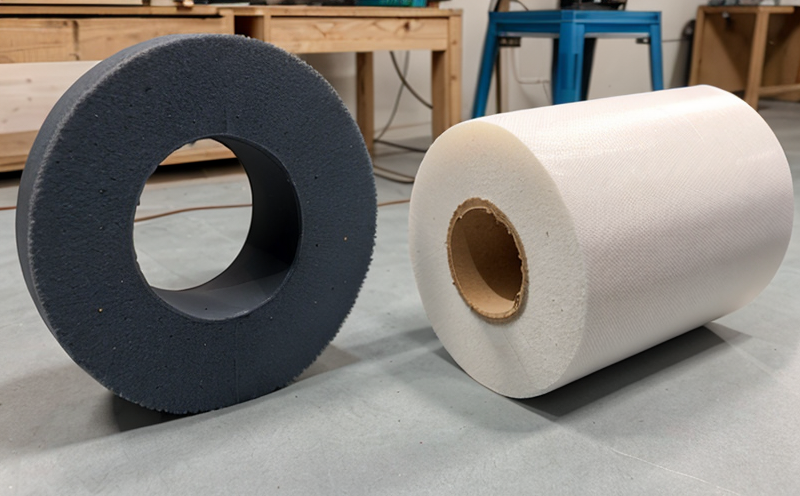ASTM D2240 Hardness Testing of Rubber and Plastic Components in Furniture
The ASTM D2240 hardness test is a crucial procedure used to measure the resistance of rubber and plastic materials to indentation. This testing method plays an essential role in ensuring that furniture components made from these materials meet the required quality standards and performance expectations. The test involves pressing a standard indenter into the material at a controlled force, then measuring the depth of penetration. The resulting hardness value indicates how resistant the material is to indentation.
For furniture manufacturers, this test is vital for several reasons. It helps in identifying materials with optimal resilience and durability, ensuring that products are safe and comfortable for consumers. By using ASTM D2240, quality managers can monitor the consistency of their production processes, ensuring that all components meet rigorous quality standards.
The hardness value obtained from this test is critical for various applications within furniture manufacturing. For instance, it helps in selecting materials suitable for cushioning and padding, where high resilience is required. It also ensures that leg supports and other structural elements are robust enough to withstand the pressure exerted by users over time without deforming.
The ASTM D2240 hardness test is particularly useful in evaluating the long-term performance of furniture components under various environmental conditions. By conducting this test, manufacturers can predict how materials will behave in real-world scenarios, such as high humidity or extreme temperatures. This predictive capability allows for more informed decisions regarding material selection and process optimization.
Furthermore, this testing method is integral to compliance with international standards like ASTM D2240 itself, ensuring that products meet the stringent requirements set by regulatory bodies worldwide. Compliance with these standards not only enhances product reputation but also ensures that furniture components are safe for consumer use.
The ASTM D2240 hardness test involves a series of steps to ensure accurate and consistent results. Specimens must be prepared according to specific guidelines, ensuring uniformity across samples. The indenter and force application are critical aspects of the procedure, requiring precise calibration and operation. After testing, the depth of penetration is measured accurately using calibrated instruments.
The hardness values obtained from this test provide valuable insights into material properties. These values can be used to compare different materials or batches within a production run, identifying any inconsistencies in quality. By leveraging these data points, manufacturers can refine their processes and improve product performance continuously.
Applied Standards
| Standard | Description |
|---|---|
| ASTM D2240-18e1 | Procedure for Determining the Hardness of Rubber by Indentation. |
| ISO 48-3:2015 | Plastics -- Hardness -- Part 3: Ball Indenter Test. |
| IEC 672-1 | Rubber and plastics -- Determination of hardness by indentation using a ball indenter. |
Benefits
The ASTM D2240 hardness test offers numerous benefits to furniture manufacturers, including enhanced product quality, improved compliance with international standards, and increased consumer safety. By ensuring that all components meet the required hardness specifications, manufacturers can significantly reduce the risk of defects and failures, leading to longer-lasting products.
Compliance with ASTM D2240 also enhances a company's reputation in the market, as it demonstrates a commitment to quality and adherence to industry best practices. This compliance is crucial for maintaining customer trust and satisfaction, which are vital for long-term success in the furniture sector.
In terms of consumer safety, ensuring that all components meet the required hardness standards minimizes the risk of accidents or injuries caused by poorly designed or manufactured products. This commitment to safety contributes to a positive brand image and fosters customer loyalty.
Additionally, the ASTM D2240 hardness test facilitates continuous improvement in manufacturing processes. By regularly conducting this test, manufacturers can identify areas for optimization and innovation, leading to more efficient and effective production methods. This ongoing improvement cycle ensures that products remain competitive in a rapidly evolving market.
International Acceptance and Recognition
The ASTM D2240 hardness test is widely recognized and accepted across the globe, making it an essential tool for furniture manufacturers operating in international markets. Its widespread acceptance ensures that products meet uniform quality standards, regardless of their geographical location.
Many countries have adopted ASTM D2240 as a standard reference for rubber and plastic hardness testing, recognizing its reliability and accuracy. This global recognition enhances the credibility of test results, making it easier for manufacturers to gain approval from regulatory bodies in different regions.
The International Organization for Standardization (ISO) has also developed related standards that complement ASTM D2240, further validating its importance in the industry. By aligning with these international standards, manufacturers can ensure that their products are consistent and meet global expectations.
Recognition from regulatory bodies such as the European Union's New Legislative Framework for Toys and Furniture ensures that products comply with stringent safety requirements. This compliance is crucial for maintaining a competitive edge in the market and ensuring consumer trust.





